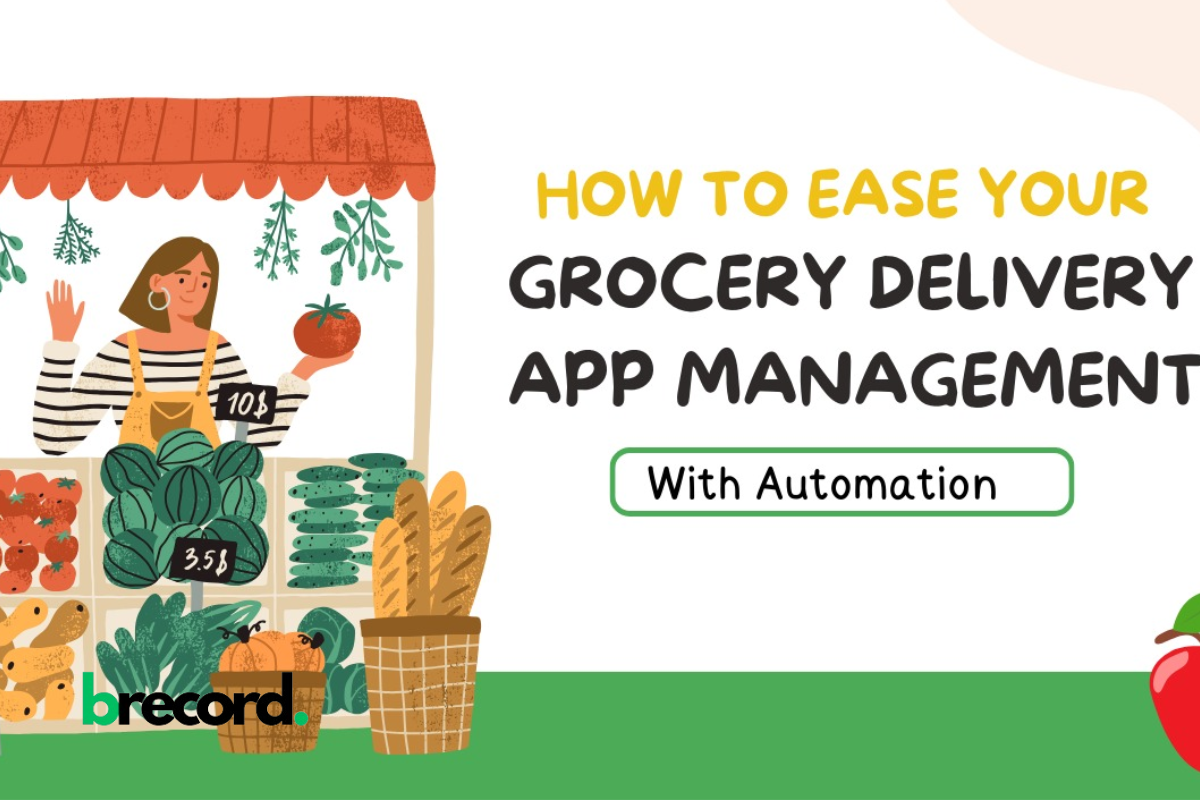In the fast-paced world of grocery delivery services, automation has become a game-changer. With the increasing demand for quick and reliable delivery, managing a grocery app manually can be overwhelming. From processing orders to managing inventory, delivery schedules, and customer communication, the complexities can quickly multiply. Automating these processes not only simplifies operations but also improves efficiency, reduces errors, and enhances the customer experience.
In this blog, we’ll dive into how you can ease the management of your grocery delivery app through automation and explore why partnering with a reliable grocery app development company is essential. We’ll also discuss the potential mobile app development cost involved in integrating automation into your app.
Ways to Ease Grocery Delivery App Management With Automation
1. Understanding the Role of Automation in Grocery Delivery Apps
Automation in grocery delivery apps involves using software and tools to perform tasks with minimal human intervention. These tasks include inventory management, order processing, route optimization, customer service, and payment processing. By automating these repetitive processes, you can save time, reduce errors, and ensure that your app operates smoothly.
The idea behind automation is to let technology handle time-consuming tasks while your team focuses on improving business strategies and customer relationships.
2. Key Areas Where Automation Can Help in Grocery Delivery App Management
Here are some key areas where automation can ease the management of your grocery delivery app:
a) Order Processing Automation
One of the most critical components of a grocery delivery app is order processing. Automating this function allows orders to be handled quickly and efficiently. From the moment a customer places an order, the system can:
- Automatically confirm the order
- Update inventory in real-time
- Assign the delivery to a nearby driver
- Notify the customer about their order status
This seamless process reduces the chances of manual errors and delays, leading to a better user experience. It also frees up your staff to focus on more critical tasks rather than managing orders manually.
b) Inventory Management
Keeping track of inventory is a significant challenge, especially in the grocery business, where perishable goods are involved. Automating inventory management ensures that stock levels are constantly updated based on real-time sales data. Automation tools can help:
- Track low-stock items
- Notify suppliers when stock needs replenishment
- Prevent overstocking or understocking
- Handle complex product catalogs with ease
This level of automation allows you to maintain optimal stock levels, reducing wastage and ensuring customers can always find the products they need.
c) Route Optimization for Deliveries
Ensuring that deliveries are made promptly is essential for customer satisfaction. Automating route planning and optimization for delivery drivers can significantly reduce delivery times and fuel costs. Automation tools can analyze traffic patterns, delivery locations, and time windows to create the most efficient delivery routes.
This process ensures that drivers spend less time on the road and make more deliveries, boosting overall productivity and reducing operational costs.
d) Customer Support with Chatbots
Customer service can make or break your grocery delivery business. Automating customer support through chatbots can provide instant responses to frequently asked questions, such as order status, delivery times, and payment issues. Chatbots can also handle simple complaints and requests for refunds or replacements without human intervention.
Not only does this improve response times, but it also allows your human support team to focus on more complex issues that require personalized attention.
e) Automated Payment and Billing
Automation can streamline the payment process by automatically processing payments, generating invoices, and sending them to customers. You can integrate multiple payment methods into your app, allowing customers to pay using credit/debit cards, digital wallets, or even cash on delivery. Automating these payment processes reduces the chances of errors and speeds up the entire transaction cycle.
3. Choosing the Right Automation Tools for Your Grocery Delivery App
When incorporating automation into your grocery delivery app, it’s crucial to choose the right tools. These tools should align with your business model and meet the specific needs of your grocery delivery operations. Some of the critical automation tools to consider include:
- CRM (Customer Relationship Management) Software: Helps manage customer data and interactions.
- Inventory Management Systems: Ensures stock levels are updated in real time.
- Delivery Management Platforms: Assists in route optimization and delivery tracking.
- Chatbots: Provides automated customer support.
- Payment Gateways: Automates billing and payment processing.
Partnering with a seasoned grocery app development company can help you identify the best tools for your business. Experienced developers can customize automation features based on your needs, ensuring seamless integration into your app.
4. Benefits of Automating Your Grocery Delivery App
There are several advantages to automating your grocery delivery app management, including:
a) Improved Efficiency
Automation streamlines time-consuming processes, allowing your team to focus on tasks that add value to your business. By eliminating manual intervention in routine operations, you can significantly boost productivity and efficiency.
b) Cost Reduction
Automating various functions can reduce operational costs by eliminating the need for a large workforce to manage tasks like order processing, inventory, and customer service. While there is an initial investment in automation technology, it will pay off in the long run as you save on labor costs and reduce errors.
c) Enhanced Customer Experience
Automation enhances the customer experience by speeding up processes like order confirmation, delivery, and customer support. Satisfied customers are more likely to return and recommend your app to others, driving growth.
d) Scalability
As your business grows, manual processes can become increasingly difficult to manage. Automation makes scaling easier by allowing you to handle larger order volumes, expand your product offerings, and serve more customers without overburdening your team.
5. How Much Does It Cost to Automate a Grocery Delivery App?
The mobile app development cost for automating a grocery delivery app can vary depending on several factors:
- Complexity of Automation: The more complex the features, the higher the cost. For example, advanced AI-driven chatbots or sophisticated inventory management systems will cost more to implement than basic automation tools.
- Custom Features: Customizing automation tools for your specific business needs will also add to the development cost.
- Technology Stack: The choice of technology stack (e.g., AI, machine learning, cloud computing) impacts the development cost.
- Development Time: The longer it takes to integrate and test automation features, the higher the cost.
On average, automating key processes in a grocery delivery app can cost anywhere from $20,000 to $50,000 or more, depending on the app’s complexity and scale. Working with a professional grocery app development company ensures that the cost is optimized while delivering a high-quality, scalable product.
6. Conclusion
Managing a grocery delivery app manually can become increasingly challenging as your business grows. Automation is the key to overcoming these challenges by streamlining processes, reducing operational costs, and enhancing customer satisfaction. Whether it’s automating order processing, optimizing delivery routes, or integrating chatbots for customer support, automation can significantly ease the management of your grocery app.
If you’re looking to implement automation in your grocery delivery app, working with an experienced grocery app development company is essential. A professional development team can guide you through the process, ensuring that your app is equipped with the right tools to succeed in today’s competitive market.
While there is a mobile app development cost associated with integrating automation, the benefits far outweigh the expenses, leading to long-term business growth and success.
FAQs
1. What are the key benefits of automating a grocery delivery app?
Automation improves efficiency, reduces operational costs, enhances customer satisfaction, and simplifies scaling.
2. How does automation impact inventory management in grocery delivery apps?
Automation ensures real-time inventory updates, preventing overstocking or understocking and reducing wastage.
3. How much does it cost to automate a grocery delivery app?
The cost can range from $20,000 to $50,000, depending on the complexity and customization of the automation features.
4. Can automation improve customer support in grocery delivery apps?
Yes, automation through chatbots can provide instant responses to customer queries, improving response times and overall customer experience.
Check out our blog for more interesting reads.



